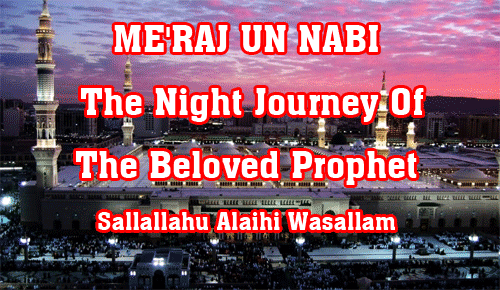The Isra and Mi'raj is one of the most significant miracles in Islamic history. It marks the miraculous night journey and ascension of Prophet Muhammad (PBUH) to the heavens. This extraordinary event is celebrated every year by millions of Muslims across the world, including India. It is a time for reflection, prayer, and spiritual devotion. In this article, we will explore the significance of Isra and Mi'raj, its historical context, and its relevance in Islamic practices, including Shab-e-Meraj ki Niyat, Shab-e-Meraj Roza Time, Shab-e-Meraj Roza Niyat, and Shab-e-Meraj Nafil Namaz.
What is Isra and Mi'raj?
Isra and Mi'raj refer to the two phases of the miraculous journey undertaken by Prophet Muhammad (PBUH) in a single night. According to Islamic tradition, the Prophet (PBUH) was transported from Masjid al-Haram in Mecca to Masjid al-Aqsa in Jerusalem (Isra) and then ascended to the heavens (Mi'raj) where he met various prophets and was granted the divine gift of Salah (prayer).
The Journey of Isra
Isra refers to the first part of the journey where Prophet Muhammad (PBUH) traveled from Mecca to Jerusalem on Buraq, a celestial steed. Upon reaching Masjid al-Aqsa, he led the other prophets in prayer, symbolizing the unity of all previous revelations in Islam.
The Journey of Mi'raj
Mi'raj is the second part of the journey where Prophet Muhammad (PBUH) ascended through the seven heavens and encountered prophets such as Adam, Ibrahim, Musa, and Isa (peace be upon them all). He was ultimately granted the vision of Sidrat al-Muntaha, the divine boundary where no creation had ever reached before. It was during this divine audience that Allah (SWT) commanded the establishment of five daily prayers (Salah), a fundamental pillar of Islam.
Spiritual Significance of Isra and Mi'raj
Isra and Mi'raj hold immense significance in Islamic theology. The journey symbolizes divine mercy, spiritual elevation, and the Prophet's (PBUH) unique status. It serves as a reminder of Allah’s power and the rewards for those who remain steadfast in faith despite adversities.
Lessons from Isra and Mi'raj:
Faith and Devotion: Despite skepticism from the Quraysh, Abu Bakr (RA) immediately believed in the Prophet’s (PBUH) journey, earning the title As-Siddiq (The Truthful).
The Importance of Salah: The direct divine command for five daily prayers underscores its significance in a Muslim's life.
Patience in Hardships: The journey came at a time when the Prophet (PBUH) faced immense personal and social challenges, symbolizing that trials are followed by divine blessings.
Belief in the Unseen: The event is a testament to Allah’s infinite power, encouraging believers to strengthen their Iman (faith).
Shab-e-Meraj Ki Niyat: How to Observe the Night
Shab-e-Meraj, or the Night of Ascension, is a night of deep spiritual significance. Muslims engage in prayers, recitation of the Quran, and seeking forgiveness from Allah. The intention (niyat) for this blessed night can be made in the following way:
“I intend to seek closeness to Allah through worship, prayers, and reflection on the night of Isra and Mi'raj.”
Shab-e-Meraj Roza Time and Niyat
Although fasting on Shab-e-Meraj is not obligatory, many devout Muslims observe it as a form of voluntary worship. The Shab-e-Meraj Roza time follows the general fasting schedule, starting from Suhur (pre-dawn meal) until Maghrib (sunset).
Niyat for fasting on Shab-e-Meraj: "I intend to fast on the blessed day of Isra and Mi'raj for the sake of Allah."
Shab-e-Meraj Nafil Namaz
Performing Nafil prayers on Shab-e-Meraj is a recommended act of worship. Here are some prayers one can observe:
Salat-ul-Tasbeeh: A four-rakat prayer with the continuous recitation of "Subhanallahi wal Hamdulillahi wa la ilaha illallahu wallahu Akbar".
Tahajjud: A late-night prayer that brings spiritual elevation.
Two Rakats of Gratitude (Shukr Salah): Expressing thankfulness for the blessings of faith and divine guidance.
Istighfar and Dua: Seeking forgiveness and making heartfelt supplications.
Why Shab-e-Meraj is Important for Muslims in India
India, home to one of the largest Muslim populations in the world, has a rich tradition of observing Shab-e-Meraj. Mosques are illuminated, special sermons are delivered, and congregational prayers are organized. The night provides an opportunity for Muslims to reconnect with their faith, seek divine blessings, and reflect on the significance of the Prophet’s (PBUH) journey.
Conclusion
The Isra and Mi'raj is not just a miraculous event but a profound spiritual experience that holds deep lessons for all believers. It emphasizes faith, perseverance, and the significance of Salah in Islam. Observing Shab-e-Meraj ki Niyat, Shab-e-Meraj Roza Time, Shab-e-Meraj Roza Niyat, and Shab-e-Meraj Nafil Namaz allows Muslims to draw closer to Allah and strengthen their faith.
As we commemorate this blessed night, let us reflect on its significance, engage in prayers, and reaffirm our commitment to the teachings of Islam. May Allah grant us all the ability to observe this sacred night with sincerity and devotion. Ameen.

























